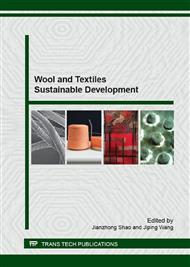p.197
p.202
p.210
p.219
p.225
p.231
p.237
p.242
p.248
Robust Superhydrophobic and Photocatalytic Cotton Fabrics Based on TiO2-SiO2-PDMS Composite Coating
Abstract:
In this work, self-cleaning cotton fabrics were prepared based on the TiO2-SiO2-Polydimethylsiloxane (PDMS) composites. TiO2-SiO2 composites were synthesized by depositing TiO2 nanocrystals onto preformed porous SiO2 and PDMS was used to enhance the linkage between TiO2-SiO2 composites and cotton fabrics. The TiO2-SiO2-PDMS composites coated cotton fabrics show superhydrophobicity with a water contact angle of 157°because of the abundant of methyl groups and hierarchical roughness features of the coated cotton fabrics. Meanwhile, the TiO2-SiO2-PDMS composites coated cotton fabrics display photocatalytic property, which were analyzed based on the removal and degradation of rhodamine B (RhB) under ultraviolet light. Abrasion resistance test indicates that the coating possesses a good mechanically durability.
Info:
Periodical:
Pages:
225-230
Citation:
Online since:
November 2015
Authors:
Price:
Сopyright:
© 2016 Trans Tech Publications Ltd. All Rights Reserved
Share:
Citation:


